#painting analysis
Text
The Two Fridas and Us (2019)

hey peeps.
so i was looking at the two fridas (frida kahlo) and it reminded me a lot of the 2019 jordan peele film us.
the way i interpret this painting is the frida in the white dress has her heart "open." literally, we can see inside it and figuratively, she's vulnerable and open to trusting others. through the veins in her heart she's tethered (get it, 'tethered?') to the other frida, which is another part of herself. that frida's heart is closed, literally we can't see inside it and figuratively, she's closed off to vulnerability and other people. the frida in the white dress cuts her veins with scissors (scissors!) and breaks the connection ('untethers!') herself from the other frida. to me, this could be because she needs to cut herself off from the other frida so both fridas can have what they want without holding each other back.
so this just screamed us to me. in us, the people above ground are mirrored by people living in tunnels underground. they're called the tethered. their lives are fully controlled by the real people above ground (they're a government experiment but that part isn't really important for this analysis), they are forever tethered together. BUT the tethered are angry at this (and honestly rightfully so, their lives suck) and they decide to come out of hiding and take revenge. they dress in red and carry scissors.
i want to talk about the scissors because that's what stood out to me the most and connects to the way the frida's are connected (tethered). in the film, the scissors represent unity for the tethered. they carry the scissors and make paper doll chains which represents the unity that the tethered feel towards each other (according to screenrant). at the end of the movie, the tethered woman (who is actually not originally tethered but besides the point for this analysis) cuts the paper dolls, slicing them apart.
now, traditionally scissors can represent cutting ties with something or someone. so when the tethered woman cuts the paper dolls, she is cutting ties with the real woman (who was originally tethered but for simplicity we are deciding that that is besides the point for this analysis). the tethered woman and real woman are mirrors of each other. the real woman has the life that the tethered woman always wanted. the tethered woman wants what the real woman has, the ability to make decisions. in order for her to do that, she needs to cut the tie because the real woman was holding her back.
the idea that to stop the real woman from holding her back, the tethered has to cut the tie really stood out to me because it seems like this painting seems to have the same theme. the fridas need to untether themselves from each other to achieve what they want to achieve (whatever that may be) without holding each other back.
thought this was interesting.
#thoughts and analysis#movies#analysis#movie analysis#painting analysis#frida khalo#the two fridas#us movie#jordan peele#Jordan peele us
5 notes
·
View notes
Text
First in a series of suggested painting analyses, we have:
The Burial of Manon Lescaut
Let's first get the details out of the way- this was painted in 1878 by Pascal-Adolphe-Jean Dagnan-Bouveret, a French artist of the naturalist school. (Naturalism is similar to realism, but not quite identical- will research and update in a later section.)
Ok, now on to the painting:
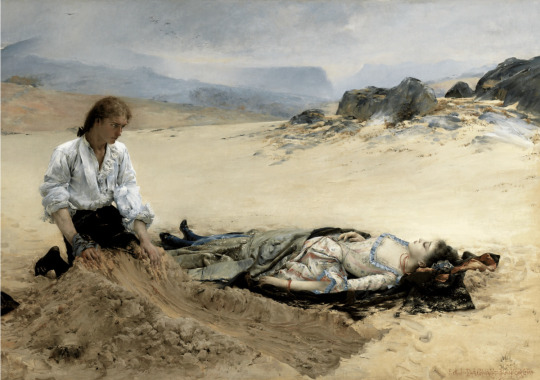
Holy shit look at the way he's looking at her. There's determination in his brows and grief in his chin and I'm half worried that he's planning on either avenging her or joining her. With the Hozier kick I've been on lately, this is not helping my romanticism about two corpses joined in death.
(Everybody please listen to "In a Week" and freak out with me about it thanks)
I really like the way the artist used foreshortening while painting the body! I think there's a cloak under her? and I love the way he's painted the sand in strokes and made it look soft and a little clayey, I love the way he's painted her scarf and shortened it because it's extending away from us- it was tricky for my eye to adjust to that at first, but with a higher res photo I could see the artist's point of view easier. That's a big problem with viewing art on a screen and not in person- you miss out on the details and perspective that the artist had intended.
Another thing I loved: I can kinda pick up on the perspective lines used in this painting. If you horizontally divide the painting into three parts, the horizon fills up the upper third and the lower textured sand and the body of Manon fills up the lower third. The man is large and adds a lot of weight to the left of the painting, but he's balanced out by the combination of Manon and the pile of rocks in the top right. There's more I'm probably missing but I think it's neat! I need to add the history but I do not have two brain cells to rub together rn. So I'm going to link the history of the painting, and inform you that it's based on a famous French novel called The Story of the Chevalier des Grieux and Manon Lescaut, which was so scandalous for the time that it was banned upon publication.
That's all for today!
4 notes
·
View notes
Note
Bit of a DnD Nerd here.
You make some excellent points in your ramble but I would like to suggest something you may not have thought of.
People have talked about the (implied in such a way that I'm kind of horrified that I didn't pick up on it without someone else pointing it out to me) abuse that Virginia subjected Henry to, so have you thought about the possibility of her somehow being more involved next season?
Because there's one iconic DnD villain that hasn't been referenced in the show yet.
Tiamat, the Dragon Queen
She's a multi-headed (normally 5, but she does have a 3 headed form too), predominantly red dragon who's known as the Mother of Evil Dragons.
It's a show that heavily references Dungeons & Dragons, so I think it's fair that a "dragon" (in however loose of a term they want) make an appearance at some point, and what fits better for the final season than the Dragon Queen herself?
OOOOOOOOOH THAT WOULD BE SO FITTING??? THANK YOU FOR TELLING ME ABOUT THIS!!
I think Virginia herself is coming back for sure, but probably in the form of flashbacks and memories.
I do like the idea of Tiamat as a symbol for Virginia, or more specifically maternally linked trauma, especially based on the group who’s supposedly fighting her in Will’s painting. We’ve got the whole Party, but the front lines are Will and Mike, the target being predominantly Mike.
Will’s there at all to indicate that this is linked to Henry, given the nature of their relationship within the narrative structure. This inextricably ties Tiamat to Virginia, and through her maternally linked trauma, by association. This is why can’t be about Will himself, because Joyce is a good mother. I’ll talk more about Will’s positioning in a bit, though. Before that, I want to think about Mike.
Mike’s mother Karen is heavily paralleled to Virginia. Karen’s not a great mom, and Mike has a lot of trauma from the parental neglect he’s experienced at both her and Ted’s hands. However, Karen is the one that notices Mike is struggling and tells Ted not to go after him, among other instances (such as her telling Mike he can talk to her, but not following through, and her treating Mike well when he’s pretending to be ill in a way that’s easy for her, but dropping the ball and punishing Mike when he actually needs support).
So, this definitely feels like Mike’s battle here. Mike needs to face down the maternally-linked/familial trauma that’s been creeping up on him for years, and he’ll need the support of his friends to do it.
He’s especially going to need Will. That’s why Will is directly by his side fighting in the front line. Once again, community support becomes key. From other illustrations, Will is directly using magic to support Mike while the dragon burns his heart shield. Aka, Will using magic/love to help Mike through his emotional hurt.
I think Mike’s going to win. He’ll just need the support and love of his friends to do so.
#mike wheeler#will byers#virginia creel#karen wheeler#painting analysis#stranger things dnd analysis#stranger things analysis#stranger things
10 notes
·
View notes
Text
#omg#nice#the more you know#art#art analysis#painting#painting analysis#history#interesting#wow#damn#a huguenot#sir john everett millais#tiktok#tiktoks#@tatyanaaboutart
3 notes
·
View notes
Text

Charles Ethan Porter (1847-1923)
"Untitled (Cracked Watermelon)" (c. 1890)
Oil on canvas
Located in the Metropolitan Museum of Art, New York City, New York, United States
Porter was among the first African American artists to exhibit his work nationally and the only one to specialize in still lifes. The painting's subject—originally an African gourd brought to the New World by seventeenth-century Spaniards and cultivated by colonists—is significant. Porter chose to paint a watermelon, an earlier symbol of American abundance—and during the Civil War period one particularly associated with free Blacks—when it was increasingly defined by virulent stereotyping. By reclaiming the subject in artistic terms, Porter challenged a contemporary racist trope.
#paintings#art#artwork#still life painting#watermelon#charles ethan porter#oil on canvas#fine art#the metropolitan museum of art#the met#museum#art gallery#american artist#african amerian artist#black artists#history#art analysis#freedom#fruit#fruits#food#1890s#late 1800s#late 19th century
821 notes
·
View notes
Text
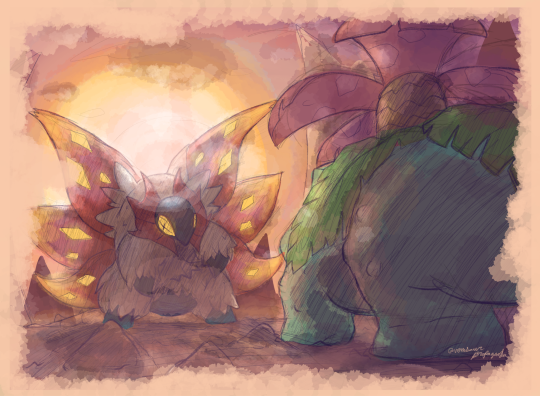
Drawing Venusaur with every Pokemon pt. Slither Wing
#***UPDATE*** Encounter with subject “Slither Wing” ended in a stalemate. Type analysis in progress...#*fig. 1* Partner Venusaur and Subject Slither Wing moments before battle#venusaur#slither wing#pokemon#paradox pokemon#pokemon scarlet and violet#fanart#artists on tumblr#digital painting#digital art#art challenge#🌺
298 notes
·
View notes
Text
I find it so SO interesting that as soon as Kazui's breaking their marriage vows and revealing his true feelings (literally tearing apart the dove), the wife is already falling off the balcony
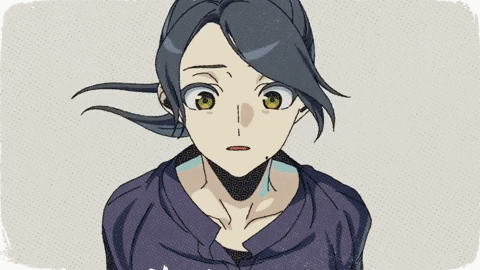
Her hair is fluttering in the wind. The apple fucking splatters on the ground this whole sequence is so visceral I'm spinning it around in my mind. Kazui views his truth telling as a violent act, the killing blow.
#milgram#capri talks#kazui mukuhara#Cat#I made a gif for this are you happy (I love this part way too much I would've made it anyway)#I have... thoughts about this which Scare me but. For now... I am going to assume in good faith that this must be taken figuratively and#symbolically because that's the most obvious interpretation right. right guys??? *one fear*#*looks at the voice drama which starts with how he's never gone up against a woman as strong as him until kotoko*#*looks at the line 'it’s generally the heavier person who ends up winning.'*#*looks at that one frame in Cat at 2:33 where he's holding her back*#DONT MIND ME IM JUST DELIBERATING I want him to be innocent I want things to be simple but I'm so worried of being hoodwinked--#--when the guy literally emphasises sleight of hand tricks and magicians and disappearing acts in his MV :'D#when he literally has a 'son of man' painting reference (man w/apple in front of face)#I am going to stop talking or else I shall combust into a million pieces#analysis#described
582 notes
·
View notes
Text
I just realized something so sweet and personal about Will's painting.
Their DnD characters don't look like that. We saw him draw them plenty in season 1. Will the Wise has a long beard and Mike's character I think has straight blond hair.
Will didn't just draw their characters per usual, he drew them as their characters. He's drawn Mike's knight character a hundred times. But he's never drawn Mike as a knight. He was understanding that Mike's character is a projection of who he aims to be, like all of them, so he drew MIke as the knight this time. For the first time.

That's what this smile is. Mike has played a hero for years. But he's never been one. He saw a dragon and probably expected his character, overjoyed with more of Will's familiar art, but instead, he was met with a glorious knight in shining armor with black, wavy hair. He was the hero this time. *(you can even see his facial expression change from happy excitement to this broad smile)
In season 1, Mike initiates the search party because of Will's heroics in DnD meaning that he would do it for them. He acknowledges that Will's actions in character are still his own. This is the same. This is Will saying "To play a hero, you have to be one yourself. And you are. I see through your character disguise. I see you. This is just the hero you've always been without the mask."
THAT is why it's different. THAT is why it's so much more personal than all the others, not just the heart, MIKE. THAT is why it hurts so bad (Will too but I'm referring to me/us).
I've said in a previous post that it wasn't about the heart, the heart was kind of for us, it was more-so about the heroism. And that's exactly what I standby. The heart isn't the only new thing about this painting. The hero has never actually been Mike before. And Will responded "Yes it has been. It always has been."
#the painting#byler#the van scene#byler analysis#mike wheeler#i might cry wtf#will byers the way you love#you love like#well you love like mike wheeler#you love like the party#you love the way the people you love love#and that is so beautiful#will byers <3#will byers#THEIR LOVE#mike calling Will a hero and Dustin a superhero in episode 1.#to this.#he finally gets it back#that one meme but in earnest#'i'm the hero?'#'you always have been'#and also without the gun in the meme#they've had enough guns this season#(they the boys never nancy)#stranger things#mike wheeler hero
326 notes
·
View notes
Text




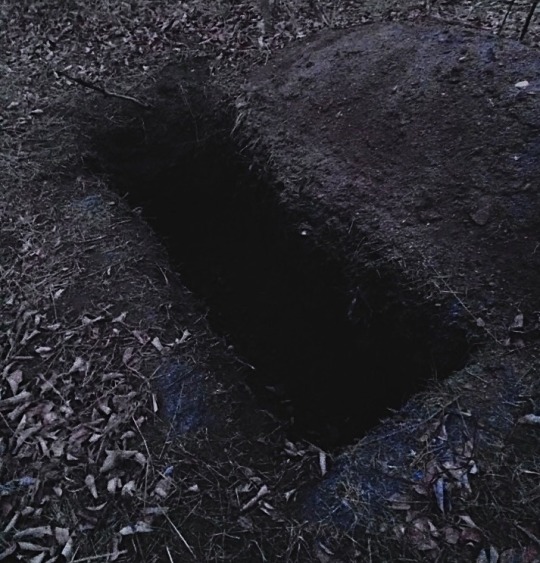
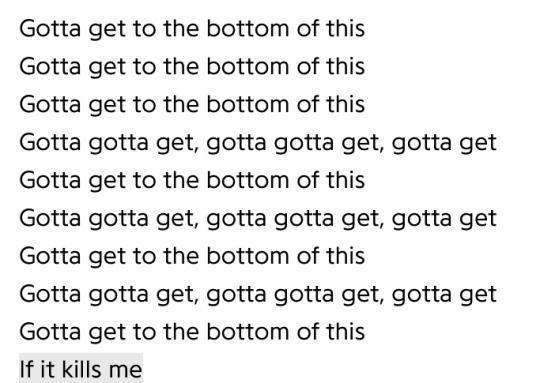




Digging too deep:
Philosophical obsession to the point of self destruction
[Image description: A collage consisting of 10 different photographs and quotes, all related to digging and holes. From top to bottom:
A wikipedia headline that says “Law of Holes”.
A close up of a shovel, digging into loose dirt.
An excerpt from a wikipedia article about the law of holes: The law of holes or the first law of holes, is an adage which states: "if you find yourself in a hole, stop digging." It is used as a metaphor, warning that when in an untenable position, it is best to stop making the situation worse.”
A lyrics excerpt from ‘The Song With Five Names’ by Will Wood: You can break a shovel when you break new ground / You dig dirt up when you dig deep down / You should know better than that by now / It's not profound to know that you could never know!
A blurry photograph of a dark rectangular hole in the ground, seemingly a grave. The hole is so dark the bottom of it isn’t visible. Besides the hole there is a pile of dirt.
A lyrics excerpt from ‘Hand Me My Shovel, I’m Going In!’ by Will Wood and The Tapeworms: Gotta get to the bottom of this/ Gotta get to the bottom of this / Gotta get to the bottom of this / Gotta gotta get, gotta gotta get, gotta get / Gotta get to the bottom of this / Gotta gotta get, gotta gotta get, gotta get / Gotta get to the bottom of this / Gotta gotta get, gotta gotta get, gotta get / Gotta get to the bottom of this / If it kills me
An excerpt from a wikipedia article about the law of holes: The second law of holes is commonly known as: "when you stop digging, you are still in a hole."
A photograph of a deep round hole. There’s a ladder going down into it and the bottom of the hole isn’t visible.
An excerpt from the transcript of episode 88 of The Magnus Archives: It was very strange. It was just the one word, solid capital letters in a small, neat typeface at the very centre of the page. It said ‘DIG’. I took that to be the title, and turned to the next page. ‘DIG’. Exactly the same. The third page. ‘DIG’. The fourth page. ‘DIG’. Dig, dig, dig, dig.
A lyrics excerpt from ‘Hand Me My Shovel, I’m Going In!’ by Will Wood and The Tapeworms: Looking down I could say heaven sent me / Hand me my shovel, I’m going in!
/end ID]
[‘Law of Holes’ - Wikipedia, ‘The Song with Five Names, a.k.a. Soapbox Tao, a.k.a. Checkmate Atheists! a.k.a. Neospace Government, a.k.a. You Can Never Know’ - Will Wood and the Tapeworms, ‘Hand Me My Shovel, I’m Going In!’ - Will Wood and the Tapeworms, MAG 88 ‘Dig’ - The Magnus Archives]
#web weaving#web weave#the buried#the magnus archives#will wood#paralells#spilled thoughts#horror#anyways- I’ve been kinda deeply obsessed about how academic and philosophical obsessions can lead to self destruction#in the form of overthinking and over analysis#never done web weaving before but I really enjoyed this!!#(this is deeply inspired by ‘Self Ish’ by will wood if you couldn’t tell)#I also had a really nice hamlet quote I wanted in this but alas the picture limit#(That and an amazing devil lyrics)#but also don’t take this too seriously#it’s more of a musing than anything actually ‘artistic’#more of a macaroni and paint collage than a poem yk?#all the photos are just stockphotos I’ve edited slightly btw#Maria’s stuff#mariacore#cw claustrophobia#tw claustrophobia#tw death#tw self destructive behavior#tw self sabotage#let me know if I should tag anything else!#image described#(God I hope it was the right choice to add all the hand me my shovel lyrics)
575 notes
·
View notes
Text
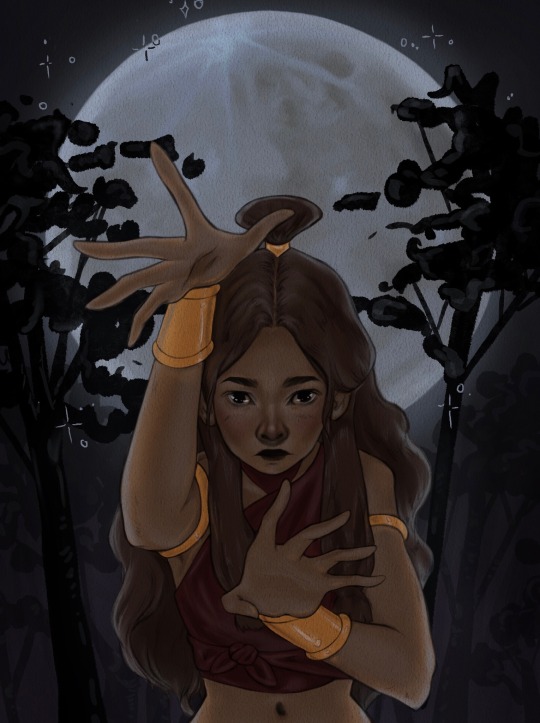
i rise with the moon
- artist musings under the cut -
since i first watched atla as a kid, i've wanted katara to embrace blood bending. she was so powerful and imo the skill wasn't as immoral as the show depicted it.
also, i rewatched the puppetmaster ep last night, and i thought about how intense of a character hama was. she found a way to survive being held and tortured as a prisoner of war for decades, developed a new form of waterbending to escape, and then the ptsd from that resulted in her becoming a serial killer/kidnapper. fascinating. tragic. i want to know more.
then katara emotionally connected to this woman from the same culture, who could teach her southern water tribe bending techniques that she thought were lost to genocide. but hama had turned to violence against non-military citizens of the fire nation, much like jet did, because of the abuse (war crimes?) they endured. it's another character that katara related to about the affects of the war, only to learn that they chose violence. reflecting on this, the scene where she chose not to kill the man who murdered her mother is even more powerful because she chose to break that cycle.
#this is the most show analysis ive ever done#atla#avatar the last airbender#katara#waterbending#avatar#digital art#digital illustration#digital painting#artists on tumblr#illustration#painting#art#drawing#procreate#aang#my art#curs-ed-cat
257 notes
·
View notes
Text
my only issue with the Rothko On Paper exhibit is the curators did not talk about paper
like the fact that these Rothkos are On Paper is significant enough to be included in the title. A lot of the plaques mentioned that Rothko thought very highly of his works On Paper (he would gift them to friends and display them in his own house, and made some commissioned pieces on paper too)
there definitely is an idear in museamy art that paper=practice=not as important and on the one hand it pisses me right off due to papercraft being my primary medium (i'm a generalist but if I had to pick just one I'd go with paper) but on the other hand I get it because paper is cheaper than canvas and Museams Are Full Of Canvasses From The Old Masters. See also: the Cezanne Drawing exhibit at the NYC MoMA in 2021, a lot of those were legit sketchbook/practice/unfinished pieces unlike the Rothko On Paper pieces which were all (except for four) finished pieces
I legitimately don't think this is from my bias as a papercraft or science person, I do think this is an oversight on the curators that they didn't talk about the paper. The plaques would say wove paper water color paper or just like not mention the type of paper. The paints were tempura or oil or water color or ink and all of those sit on top or soak into different kinds of paper in different ways
idk I just think that the material that the art is on is part of the art, it's more than just a holder for the art. and I think that's especially true for Rothko's technique of diluting and layering paints. There's a clear disconnect that the works being on paper is important enough to be part of the title of the exhibit but not important enough to be talked about within the exhibit.
the selection of the pieces was great, the order that the pieces were presented in was great, the quotes from Rothko and his personal history that was included on the plaques were great but like why even call it Rothko On Paper if you're only going to talk only about Rothko and nothing about paper. Like ok he thought there was no hierarchy between paper and canvas but WHY? what are the differences between paper and canvas?
#i'd love to see a statistical analysis showing which paint medium he used on which type of paper/canvas#like clearly he used oils on both paper and canvas#but what about ink? tempura? water color?#mark rothko
120 notes
·
View notes
Text
can you all IMAGINE being Vaggie???
you're an exorcist. You're supposed to kill demons. You're an angel. All you're life you've followed the first man, and heard tales about the dangers of questioning heaven. Tales about Lucifer. You know he's not to be messed with and that he's the king of hell. That heaven FEARS him to a degree.
then you show compassion to ONE demon once, against Adam's orders, and boom. Now you're cast out. You're stuck in hell. Oops this cute girl shows up??? She's taking care of you?? Clearly your intuition that maybe the sinners didn't all deserve to be killed were correct. She's nicer than a lot of people in heaven-WHAT DO YOU MEAN THIS PRECIOUS BEAN IS LUCIFER'S DAUGHTER???
clearly heaven was wrong about a lot of things, so if the big bad lucifer has a daughter this sweet, maybe something is up with him???
And then you meet him, and like, meeting your partner's parents is already nerve wracking and this is supposed to be THE king of hell, THE fallen angel, THE GUY THAT HEAVEN FEARS and the first thing he does is completely flub his words out of excitement, mispronounces your name, hugs you and calls you pretty???

like how weird is that to process????
#hazbin hotel#lucifer morningstar#lucifer#charlie morningstar#vaggie#mini analysis#mostly joke#I was rewatching Dad beat dad and suddenly it just sorta hit me#how weird this must have been for Vaggie#what were her previous expectations of the man??#were they good?#were they bad???#what did she think was going to happen?#was she surprised?#pleasantly or unpleasantly#actually probably pleasantly cuz he was very nice to her#then would she be like#oh duh he is an angel#or would she be floored cuz heaven painted him out to be this total villain???#WHAT IS THIS ALL EVEN LIKE FOR VAGGIE???
103 notes
·
View notes
Text
The Soul Still Burns: Analysis of the Lords of Cinder (DS3)
What follows is a short essay on the Lords of Cinder from Dark Souls 3, exploring their symbolism on spiritual and metatextual levels. After that is a related reading of Slave Knight Gael, the final adversary of the Dark Souls trilogy.
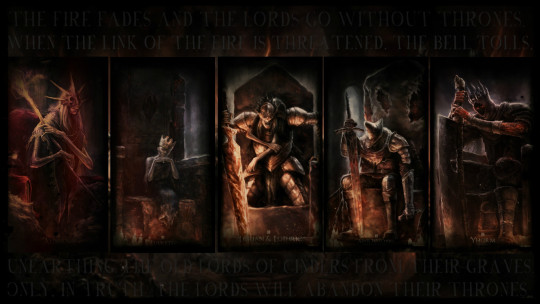
The Lords of Cinder are in many ways the primary adversaries of Dark Souls 3. This title they share, “Lord of Cinder,” refers to a personage who has rekindled the first flame, keeping the cycle of light and dark going.
Cinder is a substance which continues to burn without the presence of fire but does not reduce to ash. So euphemistically, it seems that the Lords are somehow stuck in their process of purification, and the game suggests that the world is stuck along with them; this is why it is the Ashen One’s task to “set them upon their thrones”—to hurry them along and thus allow the world to follow its natural decline. As individual characters, each of these Lords represents a different attitude that complicates and prolongs the cycle.
Through these stubborn Lords the game is commenting on at least two things. On the metaphysical level, it reflects the Buddhist idea that certain attitudes keep people reincarnating over and over again, unable to extricate themselves from the material world of suffering (samsara). While on the metatextual level, the game is suggesting that certain attitudes keep players coming back to Dark Souls again and again, starting new games, making new builds and revisiting old files.
The idea there on the metaphysical side finds an easy analogy in Buddhist doctrine: the “three poisons,” the three root causes of suffering. These are hatred, greed, and delusion. What’s interesting is that these essential vices also fit pretty easily onto the different types of players that are being caricatured by the Lords. We’ll break these correspondences down in a second.
But First: Why Do They Correspond?
So we have these sets of three. Three lords, three poisons in Buddhism, three types of Souls players. How convenient. When we analyze art, we sometimes ask, “Huh, is this structure really there, or am I projecting it into the material?” And if the structure is really there, baked into the work, that doesn’t mean that it’s due to developer intention. Archetypal forms sometimes show up in work via an unconscious influence, be it due to the cultural milieu, personal psychology, or some a priori biological disposition of the human being.
And the thing about Dark Souls is that it’s an unusually honest piece of art, in that its creative team allows their own free associations and intuitions to show up in the work without too much self-censorship or questioning. They make space for a mystery to show up on its own terms, and in leaving its riddles unanswered, there is more space for discovery by the people who play it.
It should also be said that cultural ideas persist for a reason. Beneath the ethics and ideology of the people who originally named the Buddhist “three poisons,” there may be something timeless, something perennially descriptive of human nature. If that is the case, then it would make sense for this same triplicity to unfurl itself in other cultural products. So for one reason or another, these three poisons, these addictions, show up diegetically in the characters and are also expressed in player psychology.
I say all this just because sometimes I feel very aware of the disconnect between much of Souls lore discourse and the broader field of mythological study. Since we are gamers first, there may be this tendency to want to “solve” the lore, but that’s not what we’re doing here. Myth functions because it elaborates our experience of the world through affective resonance; it attaches images and characters and stories which help us anchor our own prelinguistic impressions of the world, cultivating our sensitivity there.
Anyway, let’s look at these Lords.
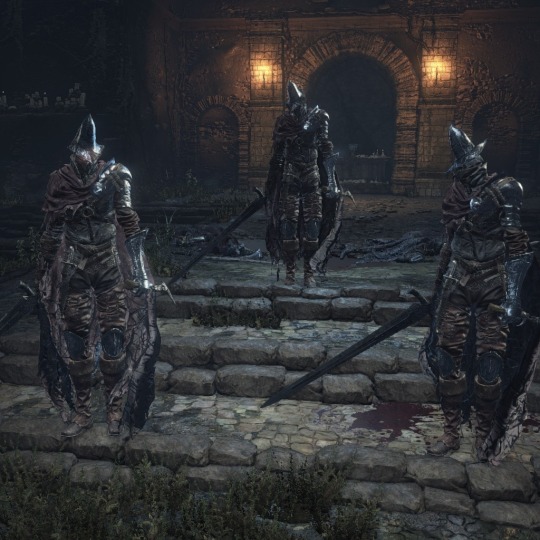
Abyss Watchers
Poison: Hatred
The lore of the Abyss Watchers is pretty clear: they have an obsessive fixation on the abyss, and are ready to raze an entire town if they suspect abyssal encroachment. This obsession has literally possessed them, as they are now “abyss touched.” Gaze too much into the abyss, etc. They carry such strong contempt for the disavowed object that they don’t care what comes between it and their sword. This is clearly demonstrated by the fact that they are a brotherhood yet are unhesitatingly slaughtering themselves again and again. Hatred has made them blind, and has also caused them to resign their individuality (they are identical, mere instruments of a transpersonal grudge). They cannot die, their hatred keeps them locked in combat.
Type of Player: competitive | Interest: combat
The Abyss Watchers are a representation of PvP addicts. They have no powers other than tenacity; they perform the same combos repeatedly. When you are really gripped by a PvP binge in Souls, you often end up doing the same thing again and again. The fight takes place in a mausoleum, on top of many chambers filled with human remains. The fact that this boss fight is instructional about combat, specifically about looking for tells (a cloud of dust always signifies the end of their combos) might be another clue. There is no limit to how good you get at Souls PvP; every foe is an opportunity to improve timing and strategy. You can just keep stacking anonymous bodies under yourself.
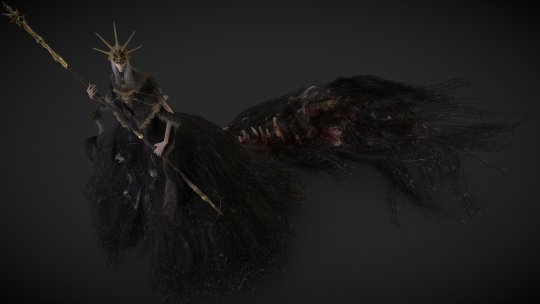
Aldrich
Poison: Greed
Aldrich invokes the concept of supremacy many times: he is in the supreme area from Dark Souls 1; in the supreme boss room of that area; he wears as a crown the former supreme lord of that area. This is because he devours lords; he tries to take prestige upon himself through acquisition and incorporation—greed.
Type of Player: completionist | Interest: content
Aldrich is a commentary on completionist players. He is someone who “plays the game to death”, acquiring every object, reaching every achievement, devouring the soul of the game through taking everything into himself. He becomes bloated by consuming as much of the game’s content as possible. The old God whose likeness he has adopted is Gwyndolin, who was, in narrative terms, the one pulling the strings in the land of the Gods. And in gameplay terms, he is a secret boss. So on both counts we have someone who is elusive, and exists more or less at the boundary of the gameworld. When a player tries to see every last little morsel of a game, they become somewhat like Gwyndolin, a manipulator of a virtual world. If you know too much about a game, you have the risk of being less immmersed.
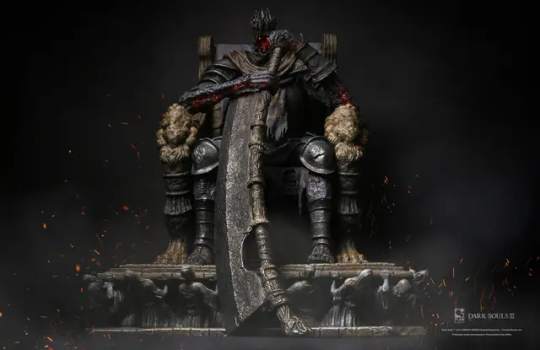
Yhorm
Posion: Delusion
In Buddhism, the poison of delusion secretly underlies the other two poisons, as the impulse toward hatred and greed are ultimately born of some false view about reality. This is akin to how the profaned capital sits below the rest of the kingdoms. To beat Yhorm you essentially have to “play pretend” with him, picking up a fake super-weapon, or fighting alongside Siegward, a knight who appears to be somewhat deluded about the state of the world, enthralled in the same fantasy as Yhorm himself.
Type of Player: lore researcher | Interest: meaning
The profaned capital is full of statues—fixed images of myth; and empty goblets—treasures with no utility. Not to mention the area with the swamp which is full of symbolic imagery, but serves no narrative or mechanical purpose. The entire profaned capital challenges us to make sense of it; it is the ultimate temptation of lorekeepers in DS3. It throws at us a disproportionate amount of reference to DS2, which is famous among Souls players as the least thematically sensible Souls game. The Greatshield of Glory is found right outside Yhorm’s room, in a conspicuous room full of treasure, and yet it is a very impractical shield and offers very little lore value. If a lore-minded player picks it up, it directs them to a legendary personage from the War of Giants, which raises far more questions than it answers. The same is true of much of this area—the Eleanora, the Monstrosities, the Profaned Flame itself—they are all there to get you to speculate. These are the players who come to Souls games again and again, trying to find the “ultimate meaning.” They seek the grail, claim to find it, and then chuck in a pile with the others.
Yhorm's story also imitates the primordial Artorias myth: forsaking his shield in preservation of something more valuable. Other than that Yhorm is largely a cipher when it comes to biography, with a void for a face, which itself epitomizes what must remain at the center of mythology and storytelling: mystery.
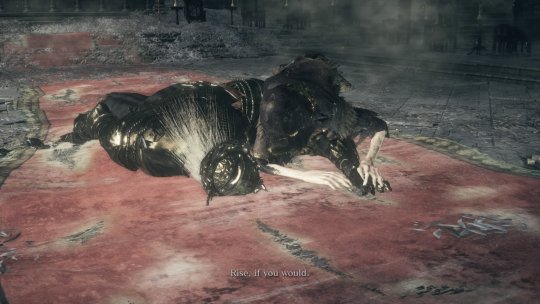
Sit Down and Seek Guidance
So we have the three reasons that people become fixated on Souls: the combat, the achievements, and the mystery. But there is a fourth lord of cinder boss, who is conceptually apart from these three: the Lothric Twins. They represent yet another kind of person who must keep playing Dark Souls: the developers. Lothric is striving to produce “a worthy heir,” a proper sequel to Dark Souls 1. The Princes are bound to their chamber as the developers are bound to their project, as that is their curse—“but you may rest here too, if you like.” In this context we can see their duality as the dual nature of having to work on the game and also play it to death. The privilege and the loftiness of the promise of a great piece of art (Lothric), and also having to go back "into the trenches" of the work itself (Lorian). Notably, neither of them can walk, they just teleport around. They are stuck at work, trying to bring the new world into being. Also I can’t go this whole essay without mentioning the obvious: that the Ashen One is bringing Lords to their thrones, and we players and developers have to assume our little chairs and couches when we access this world.
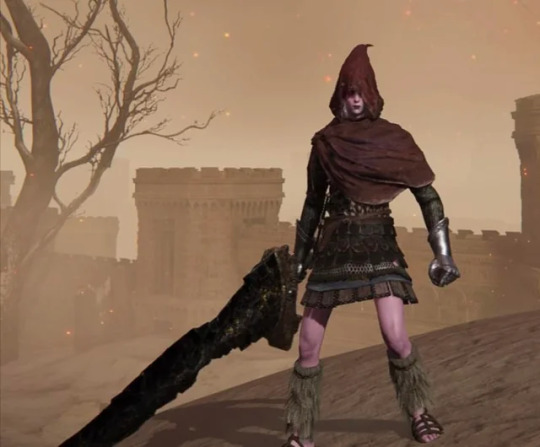
Playing Beyond the Point of Pleasure
Of course the most extreme example of someone stubbornly remaining in the world no matter what is Slave Knight Gael. He is looking for pigment, which seems to be a euphemism for the substance of humanity (the Dark Soul). He wants to give it to the painter, the world-creator, so that a new world can be made. He is willing to indulge in a wasteland of abject violence for as long as it takes in order to renew something. Ironic that he is probably only prolonging the current world in his obsessive drive to recycle it faster.
Let’s examine the relationship between the figure of the painter and her relationship to Gael. That she is a spiritual entity is obvious: we never see her touch the ground, she is always in an upper room and lifted on a piece of furniture. Among other things, she is a clear metaphor for life springing eternally. A creative child who continues to paint despite kidnapping and imprisonment. She is the heart of the painted world, itself a place that symbolizes the idea of the representation of reality.
I want to make sure this is clear, because it is a bit of a kaleidoscope to consider. Any subject in Dark Souls stands for many things, but something that the painted world specifically represents is the very concept of representation. So of course the places in our imaginations are painted worlds, but so is this physical world of appearance, the maya of mundane reality. Not to mention that a work of art is a painted world, and the game we’re discussing is a painted world. When a work of art is able to recreate itself in itself, we can see this funny effect of mirrors reflecting mirrors infinitely. This results in seemingly inexhaustible symbolic content—there is so much potential to find meaning and create connections. Because Moby Dick represents a work of literature; the Tempest represents a play; Twin Peaks represents a TV show, these works can offer extensive insights not only into their medium but into the nature of reality. In these and other examples, the representation of the medium within the work may or may not be a single subject, but since Dark Souls is formally a game about levels and level design, the painted world is the heart of its self-reflexivity. The painted world can be pointed to as the summary of this fractal device. And the personification of that device, its ambassador to the player, is the painter.
The miracle or divine child is also an archetype familiar to us from Lothric, in their struggle to produce the “worthy heir.” Reality seeks salvation through the appearance of grace. They want it in a clear, incontestable form—to be able to point at it and say, "thank goodness we went through all that, because look, now here is the meaning, here is that which validates all that came before." In the world of Dark Souls 3 the religion of the masses is the Lothric stuff; meanwhile knowledge of the painted world is much more obscure. Lothric’s religion is obviously regulated and hierarchical, while Gael’s devotion to the painter is highly personal and private: he carries around a scrap of painting; he prostrates to a hidden idol in a small chapel; he considers the painter his family. He is emotionally close to the object of his worship.
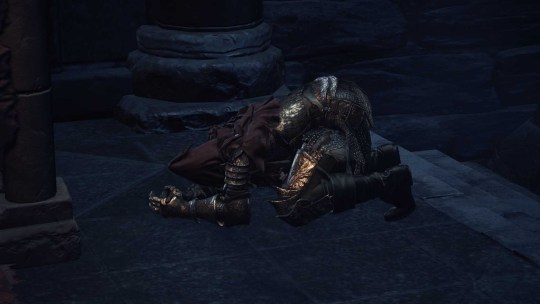
But whether it’s Lothric or Ariandel, they are anticipating the divine child to redeem the world. As an archetype, the child ultimately represents surprise. The possibility of being delighted by life in its creative novelty. The child as an archetype appears in our own behavior when we do something without any sort of contrivance or mental interference, doing something in the world which doesn’t seem to have come from who we conceive ourselves to be. This is miraculous. Such an action enchants the world, and there is no explaining it, even if it may weave all kinds of stories around itself, retroactively framing things that have led up to it as portents or promises. (Though not exclusive to him, this trait is well-known in characterizations of Christ, and DS3 is clearly indebted to Christian iconography, so do with that what you will). Regardless of the specific cultural invocation, the divine child is a personification of something that happens within the human spirit. TFW you are renewed by a fresh and spontaneous engagement with life.
The grace of the miraculous often comes to us through play. Play is more of an attitude than an activity; the feeling of play may come to us through making a painting, or chatting with a friend, or moving around in a video game. We can play video games idly, competitively, experimentally, creatively, studiously, whatever, the feeling of “play” can show up regardless. We can sit there playing a certain game from a certain motivation, and feel totally rote and joyless, and question, “Why am I doing this?” Or we might sit there and play the same game with the same motivation, feeling totally lit up by it, its purpose to us obvious and self-validating. We are not even questioning why we are doing it, we are enjoying life.
This is really the ground that the miraculous tends to land on. Grace, meaning, and an immanent love of life are more likely to show up when we are in flow and not exercising our capacity for self-assessment. But like everything in life, we mistake the images and objects around us for the feeling of grace. Any given object might only be the catalyst once; it’s not about the object. This is extremely easy to see in cases of acute nostalgia; adults chase enchantment through collecting Zelda memorabilia or going to Disneyland, in pursuit of what kindled their spirit as a child. It was never really the game or the character that was doing it, it was what they were able to access within themselves.
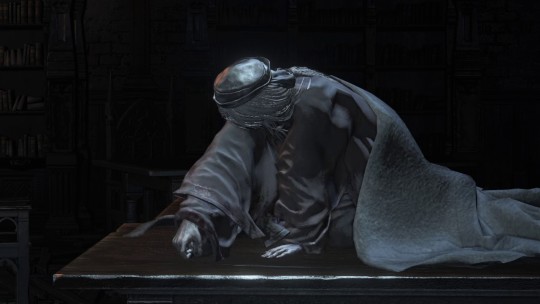
So anyway Gael has yet to realize this. He thinks the Dark Soul is out there in something else. That it will be yielded as a drop if he just kills the right enemy, or 10,000 enemies, or goes to the right place at the right time. You can see that this is something of a synthesis of all the other Buddhist defilements: there are elements of completionism/greed, violence/hatred, mysticism/delusion. There is even the suggestion of the developer of these games again, in that Gael is a “slave,” forced into participation in the world to assist some creative apotheosis. (Isn’t it funny that his weapon is a worn-down executioner’s sword?—whether the person coding or the person playing, we are all “executing” command after command). The thing that really keeps him on the wheel is something beyond any of the player types and their vices; it is almost some sort of pure, amoral automatism, a churning drive that on one side resembles wanton nihilism, and on another side single-minded piousness. Is one disguised as the other, or has Gael somehow stepped beyond this binary? Yet another dichotomy in Dark Souls that begs to be reconciled, but whose tension creates the opportunity to participate creatively in its expansive mythology. When things are held apart we can move between them.
To really understand Gael, we have to contend with the question of a person’s relationship to their own soul, since that relationship is so plainly suggested by Gael and the painter. (This question, by the way, is much elaborated in Elden Ring, with its repeated foregrounding of the image of the maiden or “consort”). If we were to see Gael and the painter as partitions within one person--whether she is his soul, or his inner life, or his better nature, whatever—then in any case Gael is the side which goes out into the world and experiences it. He is the creative extension into the world as its active participant and realizer. Yet he is clothed as the warrior, the executioner. While the one who is dressed as the artist, the painter, just stays in her room and imagines the world—but this is where the magic of creation is really felt. We involve ourselves in life, or in a game, but we are only really changed and renewed when that exterior experience is “brought home” into the inner life. We do something “in the game,” but the act of “painting,” in renewing the world through our creative interpretation, is a decidedly interior experience.
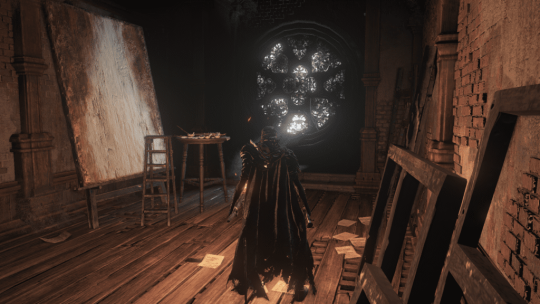
#dark souls#dark souls 3#lords of cinder#game entrainment#dark souls analysis#dark souls lore#ariandel#slave knight gael#the painted world
74 notes
·
View notes
Text

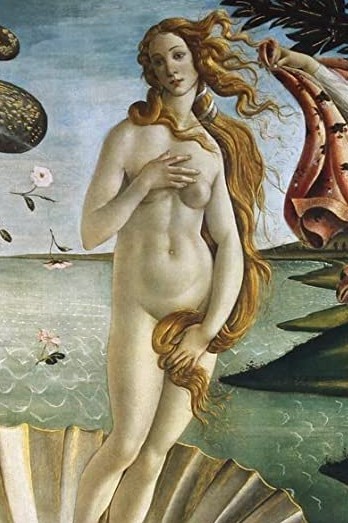
Saint Mary Magdalene by Gregor Erhart (1515-1520) // The Birth of Venus by Sandro Botticelli (1485-1486)
#art history#art#paintings#paintings of women#Aphrodite#venus#mary magdalene#saint mary magdalene#the birth of venus#sculpture#sculptures#15th century#15th century art#16th century#16th century art#art analysis#Tempera#wooden sculpture#Italian Renaissance#renaissance#Sandro Botticeli#Gregor Erhart#gothic sculpture#gothic art
647 notes
·
View notes
Note
Titus was not the victor. But would you mind drawing him?
As someone who consider herself one of the biggest D6 stan in the fandom of course I don't mind drawing the only named character from the District (in the original trilogy)
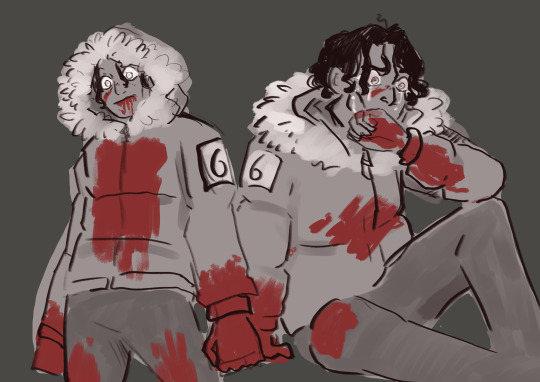
Feel like Titus is such an interesting character that Katniss mentions off handily. It shows how brutal the games can get that one of it's players will resort to something so taboo to survive. And how that amounted to nothing because the Capitol still killed him for it. Kind of shows just surviving isn't enough, you also have to be entertaining and palatable. Really hammering in that it's reality TV, not just a death match.
With the context of TBOSAS it makes sense why they weren't rooting for him. It hit too close to home. Instead of being the reflection of the "worst" from the District, he became a reflection of the worst from the Capitol. Which explains why they would never accept him as Victor.
Sidenote, I think it's interesting how it's also meta in the way Capitol "propaganda" gets to the reader. So many fanworks I have seen with him in it just takes it at face value that he must have been a crazy monster, instead of a starving kid stuck in an arena with no food seeing how he ended up being killed by an avalanche. It's interesting in my opinion.
Have more thoughts but I'll spare those for my fic so yeah so if you are reading that...there's something to look forwards to or maybe not it's rather bleak
#blood#tw blood#the hunger games#thg#thg fanart#district 6#titus#titus thg#eva answers stuff#fan art#clip studio paint#artists on tumblr#also had a phase earlier this year reading up stories with people being forced to resort to eating dead people to survive#like the flight 571 story and the donner party#i think his situation was more like those instead of someone who just ate human just because he felt like it like certain serial killers#digital art#this became way more meta than fan art#but don't get a lot of chances to share my opinions on stuff and analysis stuff so here you go
142 notes
·
View notes
Text
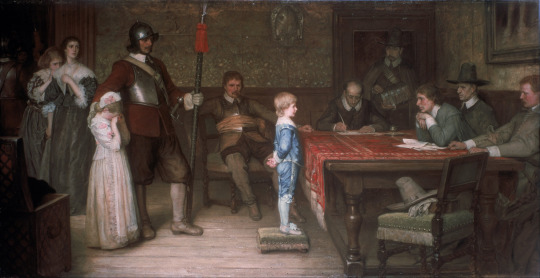
William Frederick Yeames (1835-1918)
"And When Did You Last See Your Father?" (1878)
Oil on canvas
Located in the Walker Art Gallery, Liverpool, England
The oil-on-canvas painting, depicts a scene in an imaginary Royalist household during the English Civil War. The Parliamentarians have taken over the house and question the son about his Royalist father (the man lounging on a chair in the centre of the scene is identifiable as a Roundhead officer by his military attire and his orange sash).
Yeames was inspired to paint the picture to show the crises that could arise from the natural frankness of young children. Here, if the boy tells the truth he will endanger his father, but if he lies he will go against the ideal of honesty undoubtedly instilled in him by his parents.
The boy in the picture is based on Thomas Gainsborough's painting The Blue Boy. It was modelled by Yeames's nephew, James Lambe Yeames. Behind the boy, there is a girl, probably the daughter, waiting her turn to be questioned. The girl was based on Yeames's niece, Mary Yeames. At the back of the hall at left the mother and elder daughter wait anxiously on the boy's reply.
The scene is neutral: while the innocence of the boy is emphasized by his blond hair, open expression and blue suit, the questioners are also treated sympathetically; the main interrogator has a friendly expression, and the sergeant with the little girl has his arm on her shoulder as if comforting her.
#paintings#art#artwork#history painting#english civil war#william frederick yeames#oil on canvas#fine art#walker art gallery#museum#art gallery#english artist#british artist#history#costume#costumes#interior#art analysis#child#children#snitches get stitches#1870s#late 1800s#late 19th century#a queue work of art
173 notes
·
View notes